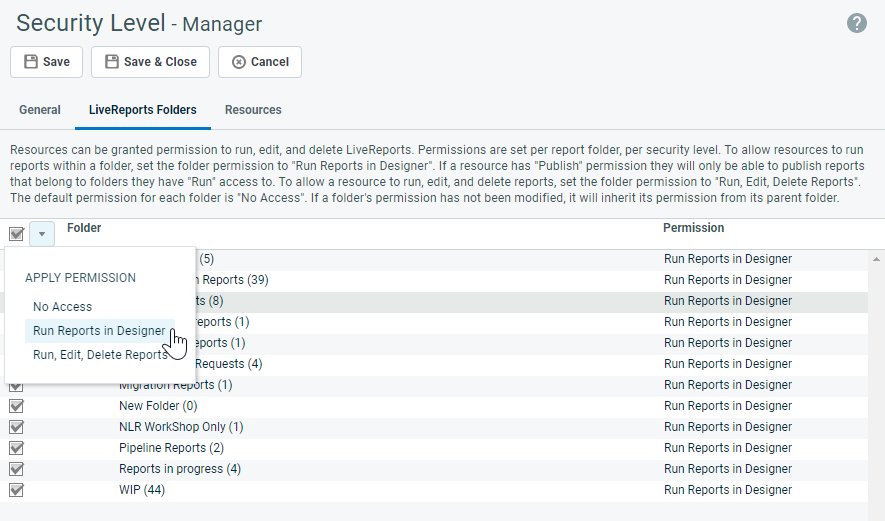ADMIN: Configuring LiveReports access and security
PERMISSIONS Security level with Admin permission to configure Resources/Users (HR). Refer to Admin security settings.
NAVIGATION Left Navigation Menu > Admin > Admin Categories > Organization Settings & Users > Resources/Users (HR) > Resources/Users (HR) > Security > Security Levels > click the Edit icon for a security level
Both the permission to create and manage LiveReports and access to the folder structure the reports are placed in are tied to a user's security level. While they are typically associated with a Manager or Administrator security level, these permissions can be added to any security level.
EXAMPLE If all of your reports will be created by one user, create a separate security level for this user. If the department managers will be creating the reports, grant LiveReports Designer security permissions to the managers. You can enhance security by disabling this feature for all other security levels.
How to...
- To open the page, use the path(s) in the Security and navigation section above.
- Expand the Reports section on the General tab.
- Under the LiveReports heading, individually enable the following settings:
| LiveReports Permissions | |
| Can access LiveReports Designer | When this option is checked, users can access LiveReports Designer from the Left Navigation Menu > Reports area. Administrators can also open LiveReports Designer from Left Navigation Menu > Admin > Admin Categories > Features & Settings > LiveReports . |
| Can manage LiveReports folders | When this option is selected, users will see Add Folder and the folder management options on the folder tree. |
| Can publish LiveReports | When this option is selected, users can see the LiveReports Publisher option in the Left Navigation Menu > Reports area. Administrators can also publish LiveReports from Left Navigation Menu > Admin > Admin Categories > Features & Settings > LiveReports. Refer to Publishing LiveReports. |
| Can schedule LiveReports | When this option is selected, users can schedule reports and manage scheduled reports in LiveReports Designer. Refer to Scheduling LiveReports. |
- Click Save & Close.
The LiveReports Designer page can give you access to potentially all reports in your Autotask instance, not just the ones that have been published to you, including custom reports created by users in your company, and system reports created by Autotask. You can copy, modify, run or delete all reports you have access to. This situation could be a potential security issue for your company.
Report folders are designed to control access to reports in LiveReports Designer. You can configure each security level to restrict or permit access to the folders the reports are placed in.
TIP Protecting access to reports is easiest if you follow our recommendation to define a security level for each job profile. You can then create a folder for the job profile, and set the permissions to No Access for all other job profiles.
To configure security level access:
- Navigate to Left Navigation Menu > Admin > Admin Categories > Organization Settings & Users > Resources/Users (HR) > Resources/Users (HR) > Security > Security Levels and click the Edit icon to open the Security Level page.
- Click the LiveReports Folders tab. The full LiveReports folder structure is displayed.
- To apply permissions to one folder at a time, click a row with a folder name. The field in the Permission column becomes a dropdown.
- To apply the same permission to multiple folders, select the folders and use the bulk menu in the upper left corner of the table to apply permissions.
- Select one of the following options:
| Permission | Description |
|---|---|
| No Access | Users with this security level do not see the folder in the LiveReports folder tree. |
| Run Reports in Designer | Users with this security level will see the folder in the LiveReports folder tree. They will be able to run, but not edit or delete the reports in this folder. NOTE This can give users access to reports that have not been published to them. |
| Run, Edit, Delete Reports | Users with this security level will see the folder in the LiveReports folder tree. They will be able to run, edit and delete reports. |
- Click Save.
NOTE If security for an individual folder has not been defined, it will be inherited from its closest parent folder. The default setting is No Access. If a folder is set to No Access, all of its child folders will automatically be set to No Access.




